
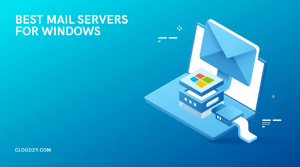
A Mail Server is like a post office running on your machine if we like emails to postal letters. The mail server software manages incoming and outgoing emails for the email accounts hosted on it and regulates the protocols used for emails. In this article, we are going to talk about the 6 best mail servers for windows that you can use.
There are many open-source or enterprise mail server solutions in the world, and here we are going to review a few of the most suitable for running on the Windows operating system. But first, let’s talk a bit about what’s important in a Windows mail server.
[lwptoc]What are E-mail Protocols?
Email protocols are a set of rules that govern how email is transmitted between Windows mail servers. There are a few different protocols available for accessing your emails, downloading emails, and sending emails. Your mail server settings will determine what protocols are used and are available for these purposes and the type of your mail client connects to the mail server. The most notable email protocols are POP3, SMTP, and IMAP.
What is SMTP?
Simple Mail Transport Protocol or SMTP is a protocol used when you send an email. Your email client and several other Windows email servers that are involved with the task will use SMTP to route the email and direct it to the recipient’s mailbox.
SMTP servers come in two variations: relay servers and receivers. Relays accept emails from users and then route the messages to the recipient. Receivers accept mail from relays and deliver the message into a mailbox. When you push send for your email, your “Outgoing Email server” will use DNS to look up the internet address behind your recipient’s email address, and then tries to contact the receiver mail server. The “receiver” should, on the other hand, have configured a DNS Mail Exchanger or MX record so that senders can find them on the internet. The relay will use that record and SMTP to deliver the message to the receiver.
[irp posts=”20526″ name=”Which Email Protocol Is Capable of Sending Emails? (SMTP, IMAP, and POP)”]What is the POP3 email Protocol?
POP3 (short for Post Office Protocol 3) is a very common protocol for incoming mails, especially among mobile users. It uses port number 110 for accessing email via unencrypted POP3. When you use encryption, which is highly recommended, the default for POP3 is 995. These are settings that you define in your email client’s settings. This is what is often called an “incoming mail server.”
With POP3 in mail server Windows, all the emails are downloaded from the server and stored locally on your PC or device. This means that you’ll be able to read your emails offline. Using POP3 also frees up some space on your server this way.
A disadvantage of accessing your mail using POP3 is for the time you try to do that on multiple devices. Your email client software needs to have an option for leaving a copy of the received and downloaded emails on the server, otherwise when your download your emails to your local machine using POP3, those emails won’t be available to other devices trying to access your mail on the mail server software.
Another disadvantage of POP3 is that if you lose the data on your PC or device, your emails will be lost. Moreover, POP3 is not that organized when it comes to storing your emails as it, doesn’t create different folders.
What is IMAP email Protocol?
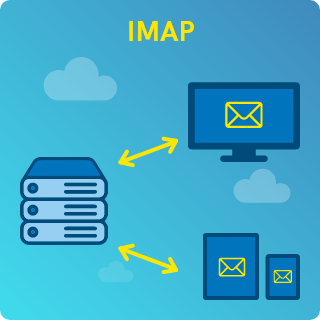
IMAP is a more advanced method to retrieve emails from your mail server. IMAP is short for Internet Message Access Protocol and is a protocol that your email client uses to sync all the messages between the server and your clients, including Microsoft Outlook and Windows mail server. Unlike POP3, IMAP leaves the original emails on the server, and so you can access your emails from any other device easily. An IMAP client can also access your inbox, sent mail, drafts, and other folders you have created, because they are all left available on the mail server.
When you are using IMAP unencrypted, the default port number will be 143. Once again, it is highly recommended to access your emails in an encrypted way. The encrypted IMAP uses port number 993 as default.
An advantage of IMAP is that it’s a little faster to start and access, since IMAP only downloads necessary information about each email at first, and doesn’t start to download the whole message until you try to open that specific message.
Compared to POP3, IMAP works much better on multiple devices. Not only it leaves the messages on the Windows mail server, but it synchronizes information on all your devices. When you open and read a message on one device using IMAP, your other devices will also show that message as read.
A disadvantage of IMAP compared to POP3 is that since it leaves the messages on the email server software, you need to download the messages every time you open your email client and try to open the emails. This may make it hard to work with on slower devices and especially on weaker connections.
[rh-cta-windows-original type=”2″ ]What is the best free mail server for Windows 10?
Windows mail servers can be found in a variety of different forms. Some are free, while others come with a price tag. The best free mail servers are those that are easy to set up and use, while also offering a wide range of features.
Let’s compare 9 best free Windows mail servers in 2022 here:
- hMail Server
- MailEnable
- Zimbra
- Apache James
- Axigen Free email server
- FirstClass
- Kolab Groupware
- iRedMail
- Zentyal

hMail is an open-source, free mail server for Windows OS from Microsoft, which is probably the best email server for Windows 10. It supports IMAP/POP3 and SMTP. With hMail Server, you are free to use any webmail that supports IMAP and SMTP. When we are talking about the best Windows mail servers, one of the most repeated names is hMail server.
hMail comes with built-in anti-spam functionality, that is SPF (short for Sender Policy Framework) and SURBL. Moreover, you can implement other third-party anti-spam systems as well. hMail also provides SSL encryption, mail backup, virtual domains, MX backup, and more. You can download hMail Server from here.
Also Read: How to set up your own Mail Server?

Another one of our best Windows mail servers is called MailEnable, which is a mail server software that comes both in free and paid versions. The paid version comes with a great range of features, however, the free version of MailEnable is just enough for the average user. It supports POP3, free SMTP server Windows, and IMAP-based email services.
- In addition to managing your mail, MailEnable free offers a lot of other features:
- AJAX webmail client
- POP and SMTP mail services supporting unlimited users and domains.
- Manage all your contacts in your web browser
- Webmail Calendar
- Appointment Scheduling & Invitations
- Free & Busy Scheduling
- Webmail Tasks
- Control Panel Integration
- Out-of-Office Start/End Times for Autoresponder
- SMTP Authentication, Integrated Windows Authentication, Relay control.
- Anti-Spam- PTR record checking, DNS blacklisting, auto-banning of IP addresses, and more.
- Management Console
- Inline YouTube Player and MP3 Media Player
You can download MailEnable Free version from here.
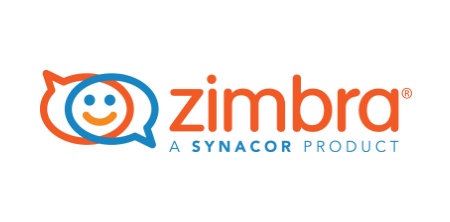
Zimbra is another great free and open-source Windows mail server that you can download on 32-bit or 64-bit Windows 10 machines. In addition, to support common mail protocols such as POP3, IMAP, and SMTP, it offers POP over TLS, SMTP over TLS, IMAP IDLE, and more.
Security-wise, Zimbra offers SSL encryption as well as SPF anti-spam system. Apart from synchronizing your mail, it can synchronize your calendar and contacts as well. Moreover, it aggregates Gmail, Yahoo!, Hotmail (Outlook), and other POP/IMAP mail accounts.
A great feature of Zimbra is that it is a dedicated migration tool which helps users migrate from another mail server software to Zimbra very easily. It is available for desktop Windows 10 and other operating systems. You can download Zimbra from here.

Axigen is a calendar and mail server Windows with both paid and free versions. If you are reluctant to spend money on the paid version to receive Axigen’s full-featured mail server, you can use its free edition for up to 5 users.
Axigen helps you perform all the common tasks of communication and mailing. You can use it as both a calendar and a mail server on your Windows system. As a standard mail server, it supports POP3, IMAP, and SMPT protocols.
Axigen Windows mail server takes security and anti-spam very seriously and leaves no room for worries. It supports fast and secure email transfer and offers many useful features such as address book integration, contacts import and export, customizable rules and filters, and more. Apart from the desktop version of Axigen, you can find a web edition from where you can manage your admin console.
Axigen is among the top best mail servers for Linux as well. You can download Axigen mail server for Windows from here.

If you have been looking for the best free mail servers for Windows OS, you might have heard of Apache James. James is short for Java Apache Mail Enterprise Server. Apache James is a free mail server that is suitable for Windows 10, and comes with a modular architecture based on a rich set of modern and efficient components for a complete, stable, secure, and extendable server running on JVM.
By assembling the components you need, you can create your own personal solution for managing emails. Then you can custom filter them using the James Mailet Container. James is completely portable since it runs on Java Virtual Machine (JVM) and is platform-independent.
Some of the features of Apache James include:
- Support for standard email protocols such as POP3, IMAP, and SMTP as well as LMTP, ManageSieve, and JMAP
- Mailet Container: independent, extensible, and pluggable email processing agents
- Storage API: Mailbox API / Search API / User API
- Storage implementations: Cassandra / PostgresSQL / HSQLDB / MySQL / ElasticSearch…
- Administration: JMX / REST / command line
Your James server can also be used as Mail Transfer Agent, by enabling the only SMTP or as an IMAP Mail Delivery Agent.
Apache James is an open-source project, and you can download it for installation from here.
[irp posts=”6477″ name=”10 Best Mail Servers for Linux OS”]
OpenText FirstClass is not a dedicated Windows mail server. Instead, it is an all-in-one tool for teamwork, communication improvement manager, etc. With it, you can set up the mail server for yourself or your team members. It supports IMAP, POP3, and SMTP, as well as SMTP over TLS, but unfortunately, it lacks support for IMAP IDLE.
FirstClass offers SSL encryption, ActiveSync, webmail management, and more. It is available for free, but there is also a paid Enterprise edition with many additional features and dedicated support. You can download the free edition of FirstClass from here.

It is widely accepted that Kolab Groupware is one of the best free and open-source Windows mail servers. This can be attributed to a number of factors, such as its feature-richness, reliability, and ease of use. Kolab Groupware also integrates well with other software, making it an ideal choice for businesses and organizations. It supports a variety of clients such as Roundcube web frontend, Mozilla Lightning, Mozilla Thunderbird, and KDE PIM-Suite Kontact.
The Kolab Groupware has many features, including the ability to send and receive an email. Its other features are:
- Its address books allow clients to manage their contacts.
- It has a calendar that will enable users to view their schedules and appointments.
- Kolab Groupware shows file-cloud and tasks.
- This mail server supports ActiveSync and CalDAV, CardDAV, and WebDAV.
- It has a very user-friendly interface that makes it easy to learn and use.
- It gives you access to IMAP4rev1 and POP3.
- Additionally, Kolab Groupware can handle large amounts of traffic without any problems.
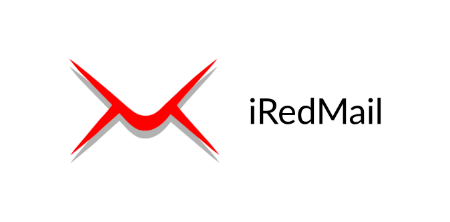
Among all free mail servers, iRedMail is one of the best Windows mail servers on the market.
iRedMail is one of the best open-source servers that is Linux-based and can be run in FreeBSD, OpenBSD, Linux, CentOS, Ubuntu, and Debian. It is easy to install and configure, and it provides a wide range of features, including:
- SMTP, IMAP, SMTP over TLS, and webmail with HTTPS connection support
- OpenLDAP, MySQL, MariaDB, PostgreSQL support
- Webmail access
- Calendar management
- Unlimited accounts access
- Quarantining detected spam into SQL
- ClamAV, SPF, DKIM, grey listing, white listing, and black listing.
- User authentication via LDAP or Active Directory
- Antivirus scanning
- Spam filtering
- E-mail forwarding and aliases
- iRedMail also integrates with popular cloud services like Gmail and Outlook.com, making it easy for users to access their e-mails from any device or computer.

If you are looking for a powerful yet easy-to-use Windows mail server, Zentyal is the perfect solution for you. Zentyal can handle large volumes of mail without any slowdown and lets you receive messages from external accounts such as Gmail and Yahoo Mail.
It includes a built-in firewall to help protect your network from online threats and also has spam filtering features that help to keep your inbox clean. In addition, Zentyal can be used as a secure email server, providing encryption and authentication for messages.
- Some of the other features that make Zentyal an excellent choice for a mail server include:
- It has an address book to access your contacts directly from your phone or tablet.
- It has calendars and notes and helps you in managing your appointments.
- Zentyal supports built-in CalDAV & CardDAV.
- This Windows mail server has the ability to filter countries as well as black listings.
Best Open Source Server
As we mentioned earlier, an open-source server is a great solution for businesses that are looking for an affordable and customizable option. Open source servers can be tailored to meet the specific needs of each business, and they are often more affordable than proprietary servers. Additionally, open-source Windows servers are often more secure, as they are updated more frequently than proprietary servers. One of the drawbacks of open-source servers is that they can be more difficult to use than proprietary servers. However, with a little training, most businesses will be able to use an open-source server effectively.
We introduced you 10 best free Windows mail servers, some of which are open source. You can compare them and choose the best one that fits your needs, but generally speaking, the best open-source server for Windows is hMail. Windows mail server software can be expensive, but there is a great, free alternative: hMailServer. It’s the easiest mail server around, and it’s free to set up and use.
[rh-cta-windows-original type=”2″ ]Free SMTP Server Windows: (What is SMTP?)
As it was mentioned, Windows mail servers have SMTP servers to send and receive emails from any computer with an internet connection. Many mail servers, such as MailEnable provide users with free SMTP server Windows. This can be a great option for small businesses or individuals who want to save money.
When looking for a free SMTP server, it’s important to make sure that the provider you choose offers features that will meet your needs. For example, some providers only allow users to send a limited number of messages each day. Others may not offer support for certain email clients or protocols. Before signing up for a free SMTP server, be sure to read the provider’s terms and conditions carefully. This will help ensure that you understand the restrictions and limitations of the service.
Free Mail Server for Old Windows Versions
Most mail server solutions that support Windows, support its older versions too since Windows 10 is a relatively new version. Especially the solutions that have been around for at least five years should do just fine on older Windows operating systems. Zimbra is an example of such mail server solutions with its support for older 32-bit systems. Although, the development of Zimbra Desktop has been discontinued since October 2019.
Another mail server solution that probably will have the least problems on an older Windows 8 or 7, is Apache James. Since this mail server is based on Java and runs on JVM, it is platform-independent and if you are running JVM 6 or above, it should work just fine on your Windows 8.1, Windows 8, or Windows 7 system.
How to Choose the Best Windows Mail Server?
We introduced you ten best free mail servers for Windows, and you may choose any of them as the best solution for your needs.
When you are looking for the best Windows mail server, you will have to consider a lot of different factors. One of the most important things to think about is how many users you need to support. If you have a small business with only a handful of employees, you may not need a very robust mail server. However, if you are running a large company with hundreds or even thousands of employees, you will need something that can handle a lot of traffic.
You also need to consider the features that are important to you. Because not all servers are created equal. For example, do you need spam filtering capabilities? Do you want the ability to easily access your mail from any device? Some servers are more reliable than others, some have better customer support, and some have more features. Once you’ve determined your needs, you can start narrowing down your choices.
Another thing to think about is your budget. Some mail servers are more expensive than others. You don’t want to invest in a server that’s too expensive or doesn’t fit your needs. The best option is to start with free Windows mail servers.
Finally, there are many factors to consider when choosing the best Windows mail server for your needs. By taking the time to research your options, read reviews, and ask questions, you can be sure to find the server that is right for you.
[irp posts=”9758″]A Comparison of the Best Mail Servers for Windows
Nearly all mail server software supports the trio of POP3, IMAP, and SMTP. But there are various other features that may come into consideration when you are choosing the best mail server solution for you to run on Windows OS.
In the table below, we are going to list and compare different features of the mentioned free Windows mail servers:
| Mail Server | SMTP | POP3 | IMAP | JMAP | IMAP IDLE | SMTP over TLS | POP over TLS | IPv6 | SSL | Webmail | ActiveSync |
| hMail Server | ✅ | ✅ | ✅ | ❔ | ✅ | ✅ | ✅ | ✅ | ✅ | ✅ | ❌ |
| MailEnable | ✅ | ✅ | ✅ | ❔ | ✅ | ✅ | ❔ | ❔ | ✅ | ✅ | ❔ |
| Zimbra | ✅ | ✅ | ✅ | ❔ | ✅ | ✅ | ✅ | ✅ | ✅ | ✅ | ✅ |
| Axigen | ✅ | ✅ | ✅ | ❔ | ✅ | ✅ | ✅ | ✅ | ✅ | Ajax, Basic & Mobile | ✅ |
| Apache James | ✅ | ✅ | ✅ | ❔ | ✅ | ✅ | ✅ | ❔ | ✅ | ❌ | ❌ |
| FirstClass | ✅ | ✅ | ✅ | ❔ | ❌ | ❔ | ❔ | ❔ | ✅ | ✅ | ✅ |
| Kolab Groupware | ❔ | ✅ | ✅ | ❔ | ❔ | ❔ | ❔ | ❔ | ❔ | ❔ | ✅ |
| iRedMail | ✅ | ❔ | ✅ | ❔ | ❔ | ✅ | ❔ | ❔ | ❔ | ✅ | ❔ |
| Docker | ✅ | ✅ | ✅ | ❔ | ❔ | ❔ | ❔ | ❔ | ❔ | ❔ | ❔ |
| Zentyal | ✅ | ✅ | ✅ | ❔ | ❔ | ❔ | ❔ | ❔ | ❔ | ✅ | ✅ |
Conclusion
Any good Windows mail server should support the most basic email protocols, meaning SMTP for sending email, and IMAP and/or POP3 for receiving or reading emails.
Other important features include support for secured connection, meaning SSL encryption, SMTP over TLS, and POP ever TLS. An anti-spam system capable of blocking most spam emails will save you a lot of time of effort sifting through emails to throw away unwanted ones.
Additional features such as a calendar and address book could be great extras if your other requirements are already met. Support for UTF8 is great when you are going to have correspondence in non-Latin languages. In the end, it is up to you to choose which one as the best Windows mail server from the list we have provided for you.
FAQ
What is the best mail server?
There is no clear answer to this because each mail server for Windows offers different functionalities and pros and cons.
What is the best open source email server?
Many of the best mail server Windows providers are open source, but the best one among them is hMail.
What is the best IMAP server?
Many of the best mail server Windows providers support the IMAP protocol including hMail Server, MailEnable, Zimbra, Axigen, Apache James, FirstClass, Kolab Groupware, iRedMail, Docker, and Zentyal.


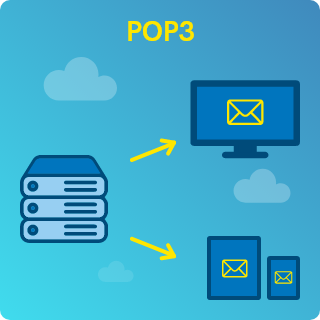

I am using hmail server but I want to switch, which of the mentioned mail servers do you suggest me to start using